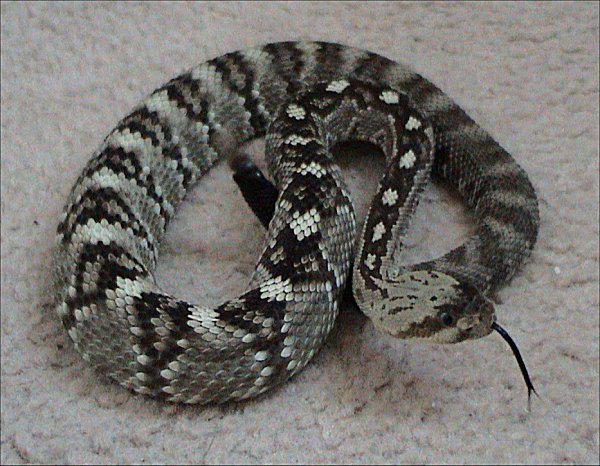Black-Tailed Rattlesnake(Pit Viper) - Crotalus molossus
The black-tailed rattlesnake is a venomous pit viper species found in the southwestern United States and Mexico. Four subspecies are currently recognized, including the nominate subspecies described here.
 |
| Black-Tailed Rattlesnake |
| Kingdom | Animalia |
| Phylum | Chordata |
| Class | Reptilia |
| Order | Squamata |
| Suborder | Serpentes |
| Family | Viperidae |
| Genus | Crotalus |
| Scientific Name | Crotalus molossus |
Description
The Black-tailed Rattlesnake (Pit Viper) is a large (< 1524 mm total length, Platt and Rainwater 2009, but most are < 1000 mm TL in Arizona), heavy-bodied pit viper. Atop the head is usually some darkening of the snout and normally a dark band or patch between the eyes, although some desert specimens lack that band. The dorsal pattern of the body is 20-41 light-edged, dark blotches or diamonds. The anterior blotches and sometimes posterior blotches have some light interior scales, and many of the dark blotches coalesce with lateral blotches and become bands, especially towards the rear of the body. The background dorsal color is greenish, gray or yellowish and each scale is unicolored. The tail is typically a distinctive uniform black or dark gray in adults. The infrequently observed neonates typically show some tail banding as do some adult snakes from the Sonoran Desert, which tend to be paler and grayer than snakes from the mountains. Montane snakes have bold patterns and the background dorsal coloration is often yellow or yellowish green or yellowish brown. The venter is cream to yellow sometimes with faint markings and a greenish tint posteriorly.
Distribution
Texas, Arizona, New Mexico, Tiburón Islands, San Estéban, Gulf of California and Oaxaca of Mexico
Behavior
In the spring and fall the Black-tailed Rattlesnake are diurnal, in the summer they are nocturnal so they can avoid the heat, and in the winter they hibernate in other animals dens. Even though they are okay climbers and good swimmers they are terrestrial. They live in grasslands, deserts, mountain areas, and forests.
Feeding
Like all rattlesnakes they are carnivores and eat rodents, other small mammals, birds, and small reptiles.
Reproduction
The Black-tailed Rattlesnakes mate in the spring, once they have mated the male stays with the female to stop other males from mating with her. It is in the summer that the female gives birth to her young, the young stay with their mother for around a day or two before leaving by their selves. A female usually mates every year and has 10-12 young at a time. They live for around 15–20 years.
Subspecies
- San Esteban Island Black-tailed Rattlesnake, Crotalus Molossus Estebanensis
- Mexican Black-tailed Rattlesnake, Crotalus Molossus Nigrescens
- Oaxacan Black-tailed Rattlesnake, Crotalus Molossus Oaxacus
Comments
Post a Comment